
Sometimes you hear about a place and feel compelled to go there for reasons you can’t quite explain. Nagoro Village, or Kakashi no Sato (Scarecrow Village), is such a place. If the name sounds somewhat strange, that is nothing compared to the experience of actually being there, as it goes beyond strange to singularly surreal.
Picture this: you travel for several hours by a combination of trains and local buses through stunning scenery, jaw-dropping steep gorges with shimmering turquoise water far below and the rolling hills of Japanese farmland to arrive at a tiny village. At first glance, the village seems busy, with “people” relaxing on their front porches, patiently waiting for a bus and working hard in the fields. But then you take a second look and you realize, these aren’t people at all. They are scarecrows, every single one of them. It is like walking into a scene from a post-apocalyptic movie where some bizarre event has turned living people into scarecrows, frozen forever in their final everyday task.
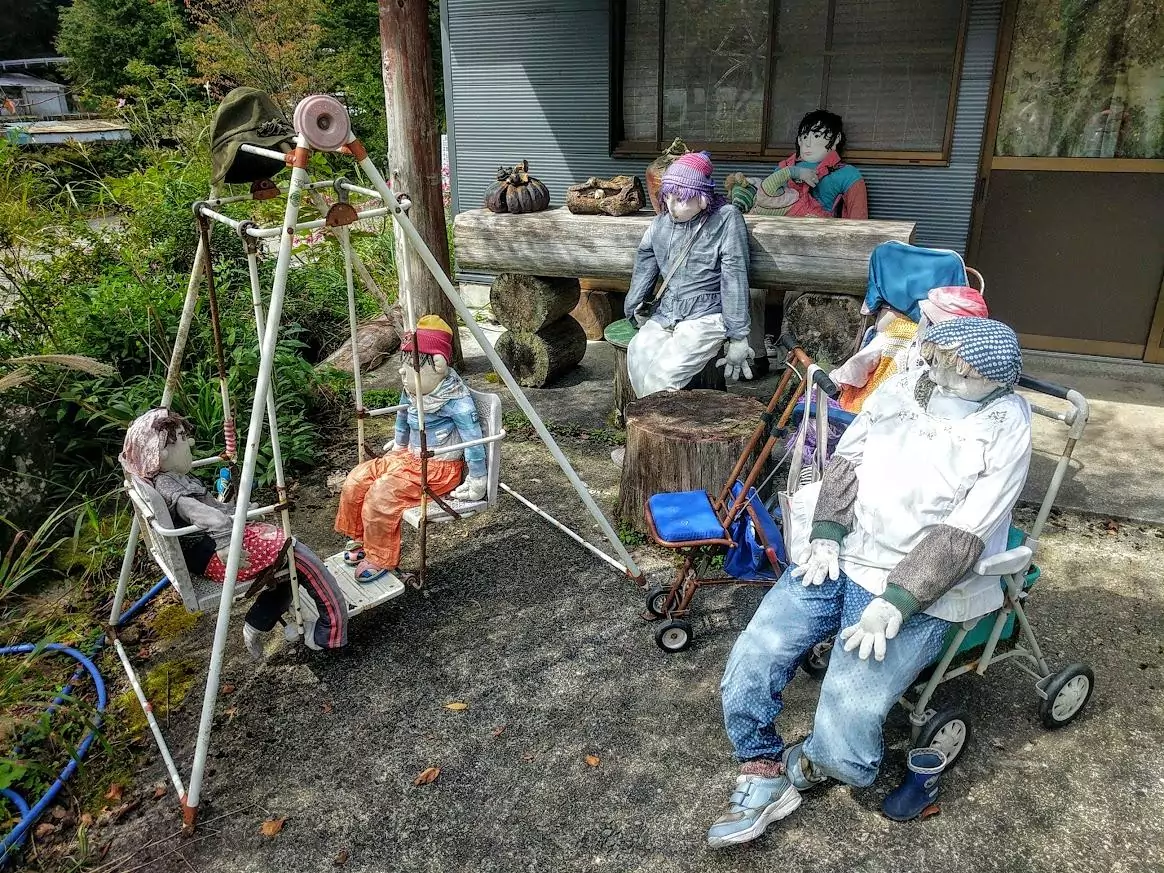
Daily life in Nagoro Village
photography by: The Brownes
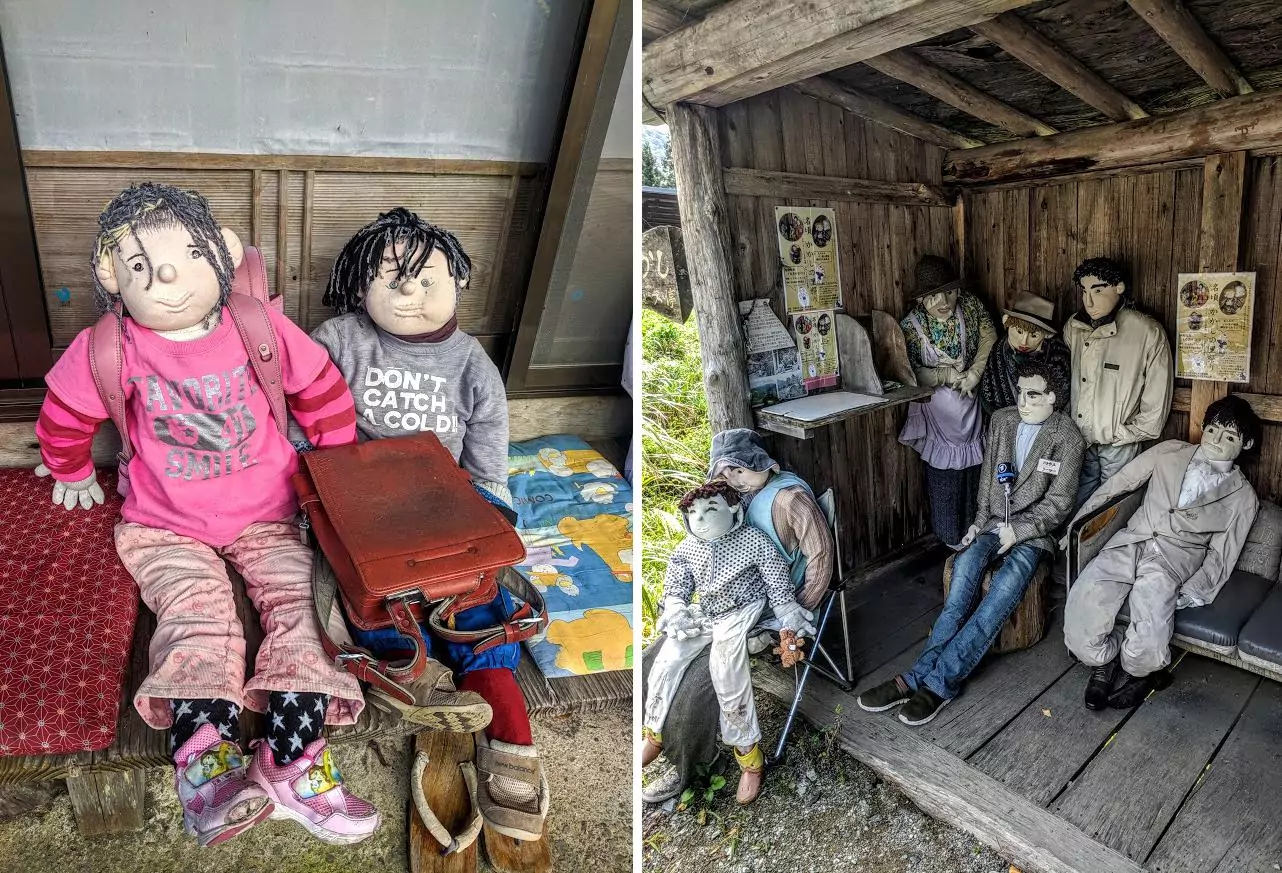
The children of Nagoro Village and a local gathering
photography by: The Brownes

A farmer pulling a cart with children inside while men work in the fields
photography by: The Brownes
This is Nagoro, a depopulating village in the heart of Iya Valley, Miyoshi, Tokushima Prefecture with less than two dozen human residents but over 350 scarecrow residents. A former resident, Ayano Tsukimi, moved back there in 2002 to look after her ailing father and when he died, she made her first scarecrow to look like him. She enjoyed the task so much that she soon had three or four scarecrow women around her house and tending her garden. She was especially amused when some passing strangers stopped to ask her scarecrows for directions so she continued to make more scarecrows, many of which are made in the likeness of former residents who have passed away or simply moved to more accessible places.

A lady makes traditional Japanese green tea
photography by: The Brownes

An old woman tends to her driveway and an old man welcomes us to the Community Center with a smile
photography by: The Brownes
The scarecrows are astonishingly lifelike. So much so that you almost feel like you are invading their privacy when you take photographs of them. Every little detail has been carefully considered. Some of the ones that really stood out for us were: the loving couple enjoying a quiet moment together overlooking the river; the elderly lady making traditional Japanese green tea; the electricity repair man lying on the roof of a house while he fixes some wiring; the skater kid in his baggy black hoody; the teenagers trying to look cool in their designer gear; the farmer pulling a cart full of children across the fields; and the workers in the woodshed wielding chainsaws. Each scarecrow is recorded on the town register, with name, ages, genders and occupations. While most scarecrows are modeled after Japanese people, there is the odd celebrity here and there, including an instantly recognizable Donald Trump.
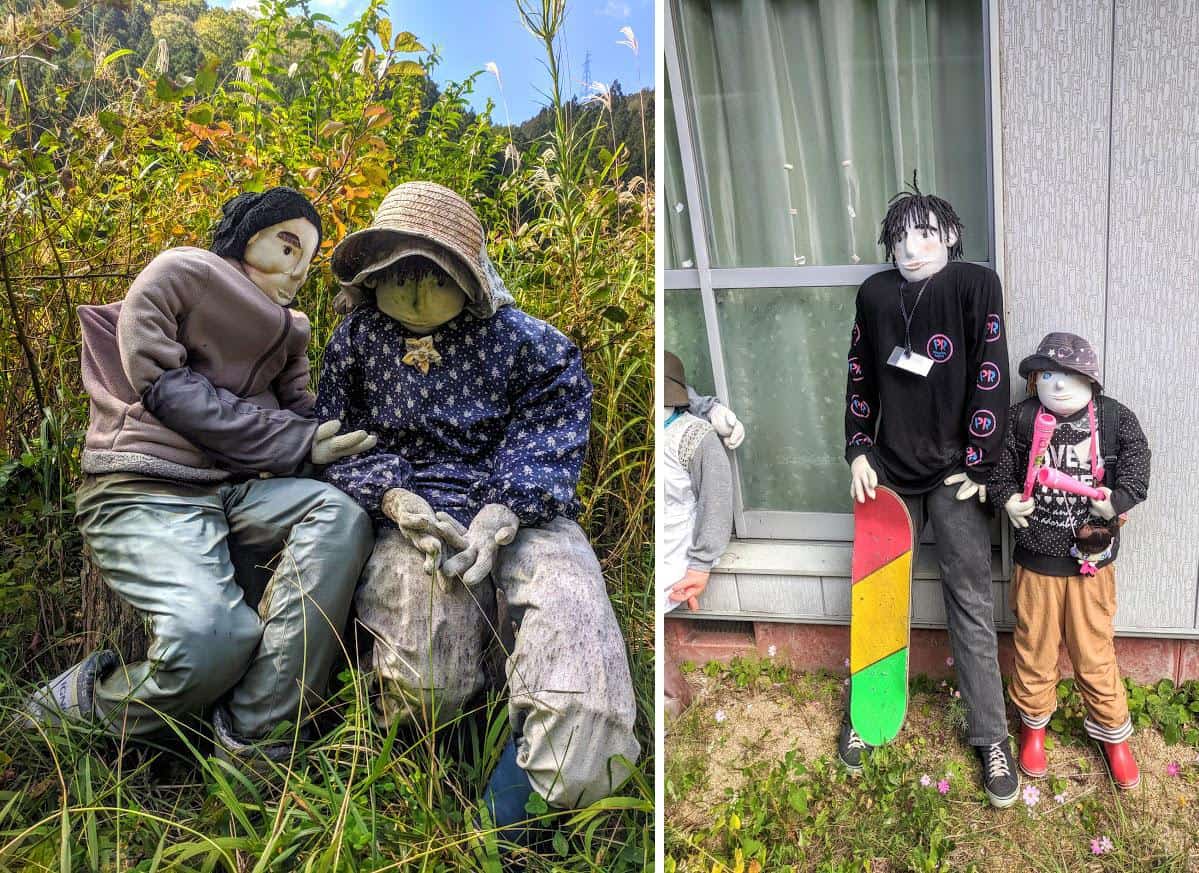
A young couple taking a quiet moment together and the town skater kid
photography by: The Brownes
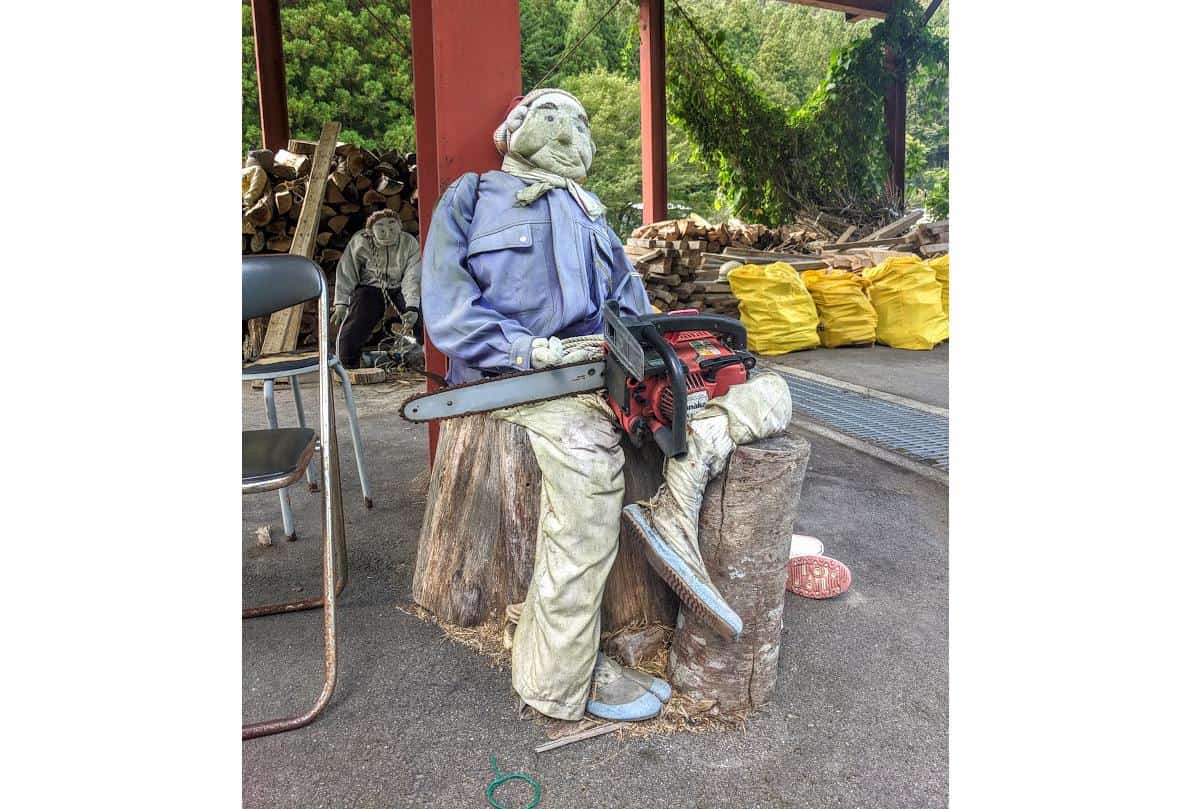
A workman with his chainsaw
photography by: The Brownes
While the whole village is a little unnerving, it is when we step inside the former elementary school that we reach peak levels of unsettlement. There are rows and rows of “children” and lessons on the blackboard. Toys and games are scattered around and the eyes of dozens of inanimate effigies seem to follow you around the room. There is a certain poignancy to this when you learn that the village is now completely childless. The elementary school closed in 2012 when the last 2 students finished sixth grade and the youngest living resident in the village is almost 40 years old. It isn’t just the school that has closed; the village does not currently have any shops, restaurants or hotels and the nearest supermarket is 90 minutes away via occasionally treacherous mountain roads. I’m not sure what the current residents think about being outnumbered 12:1 by these quiescent creations or the impact it has on their mental health. Perhaps it brings some life back to a place that would otherwise be just another dwindling rural village decimated by Japan’s aging population and the lack of employment opportunities in such remote areas.
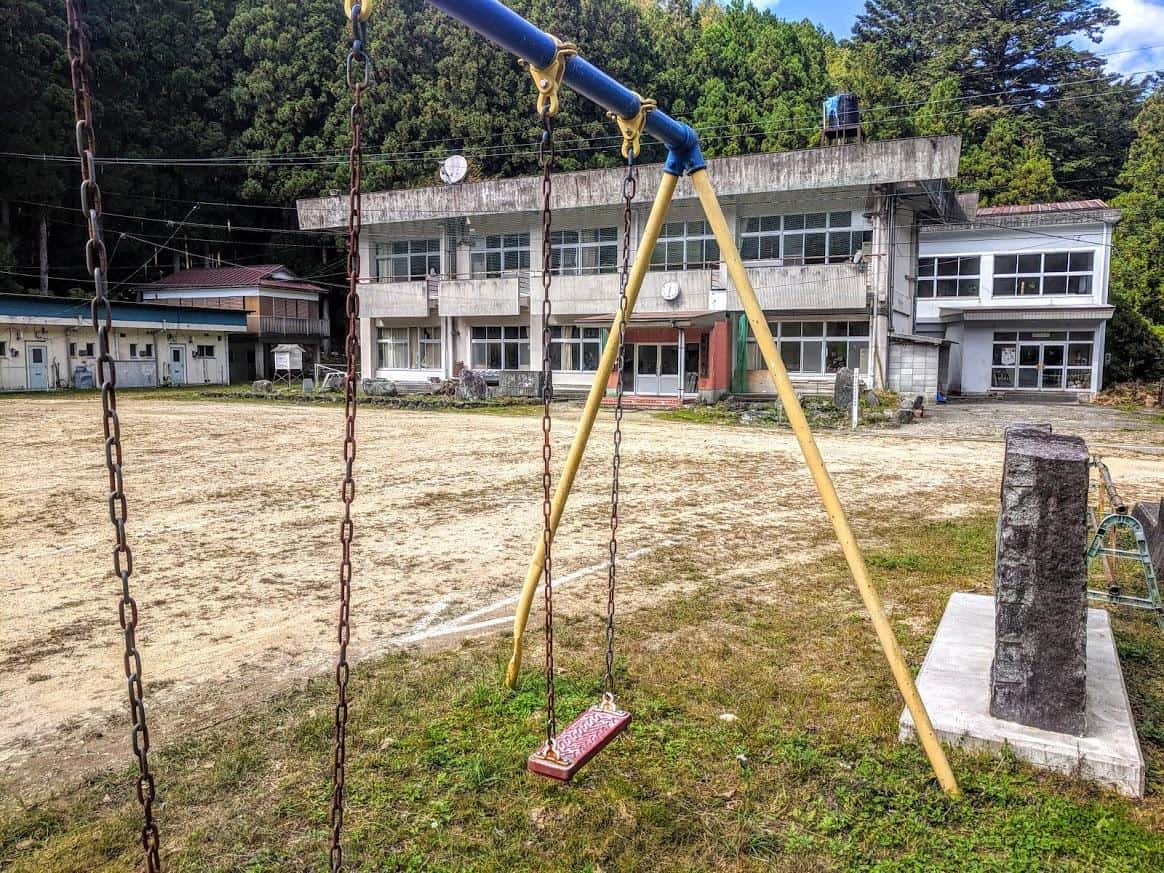
Outside the former elementary school
photography by: The Brownes
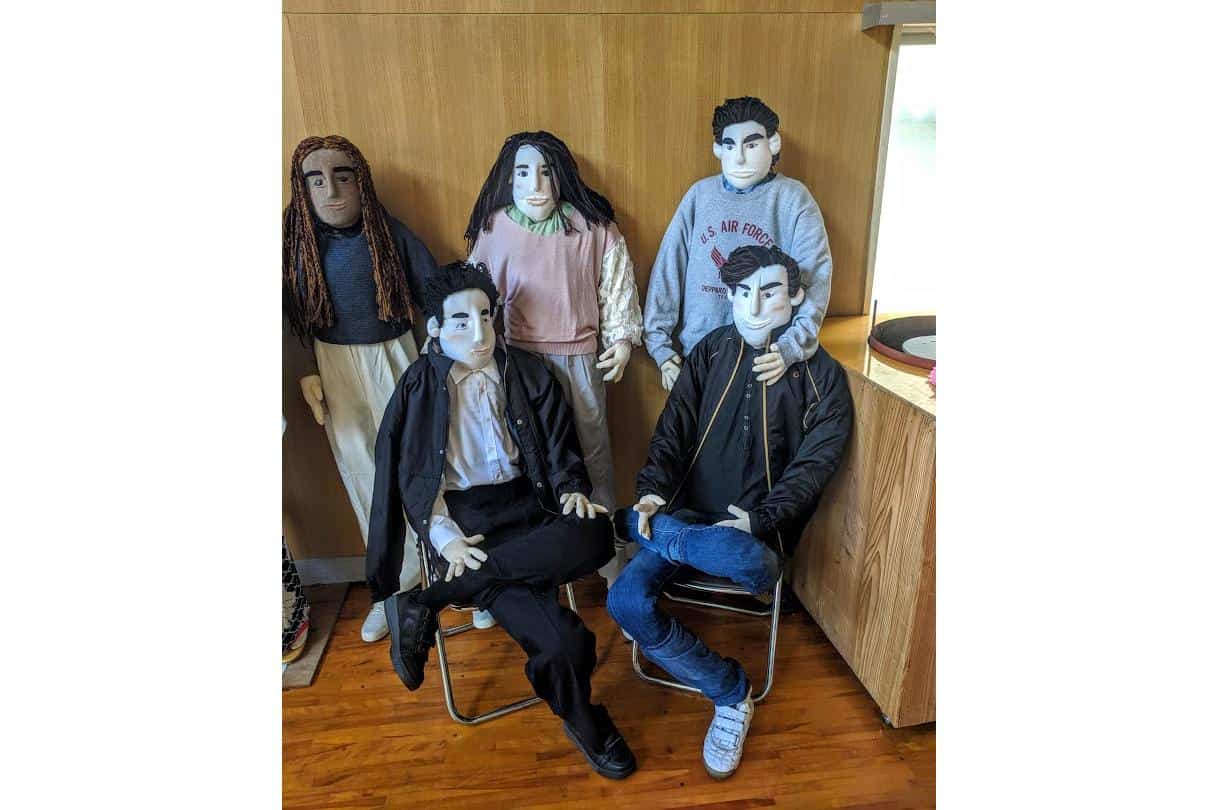
The teenagers of the village
photography by: The Brownes
Unfortunately, we did not have the pleasure of meeting Ayano-san but she has gained worldwide recognition for her scarecrow creations and at 70 years old, she has no plans to stop. People from all over Japan send her outfits for her unorthodox inventions. She runs a monthly Scarecrow Making workshop where you bring your sewing kit and clothes for your scarecrow and she shows you the rest. She also organizes an annual festival on the first Sunday of October, held beside the former elementary school and including scarecrow exhibits, photo contests, food stalls, etc. The theme varies each year – for 2019, the theme was a sports day or “undokai”, with scarecrow children posed taking part in a race, playing on a set of swings and throwing a ball around.

2019 Sports Day in the elementary school
photography by: The Brownes
It is hard not to be impressed by such an indelible place – the dedication and attention to detail employed while making these scarecrows is second to none. However, did we like it? It is hard to say. We were certainly unnerved and a little overwhelmed by it all and yet we can’t seem to get it out of our minds. It highlighted the ongoing issues in Japan’s most rural areas in a way that we will never forget. Our lasting impression may be best described as bittersweet – while we hope that these inert inhabitants provide a level of comfort and a sense of community for the living residents, it is hard to look past the losses that these figures represent. One thing is for sure, you will not find a place quite like Nagoro anywhere else in the world – it is quirky, quaint and quintessentially Japanese.
Hiking
There are numerous hikes you can do in the area. Popular areas to explore are Mt Tsurugi and the expansive area around the two gorges, Oboke and Koboke. The gorge names translate to “big dangerous steps” and “small dangerous steps” so hike with care. The clear turquoise water of the Yoshino River cutting through the gorges is a sight to behold and can be safely seen from the road.
White water rafting
We went white water rafting on the Yoshino River with Happy Raft and while the rapids were not very big at that time of year (October), the guide we went with was fantastic and very keen to make sure we had fun. Happy Raft also have a guest house where we stayed for 4 nights. It is a traditional Japanese farmhouse a little way up the mountain and staying here is a unique and fascinating experience, sleeping on the classic Japanese woven mat (tatami) floor while playful monkeys call to each other in the trees outside.
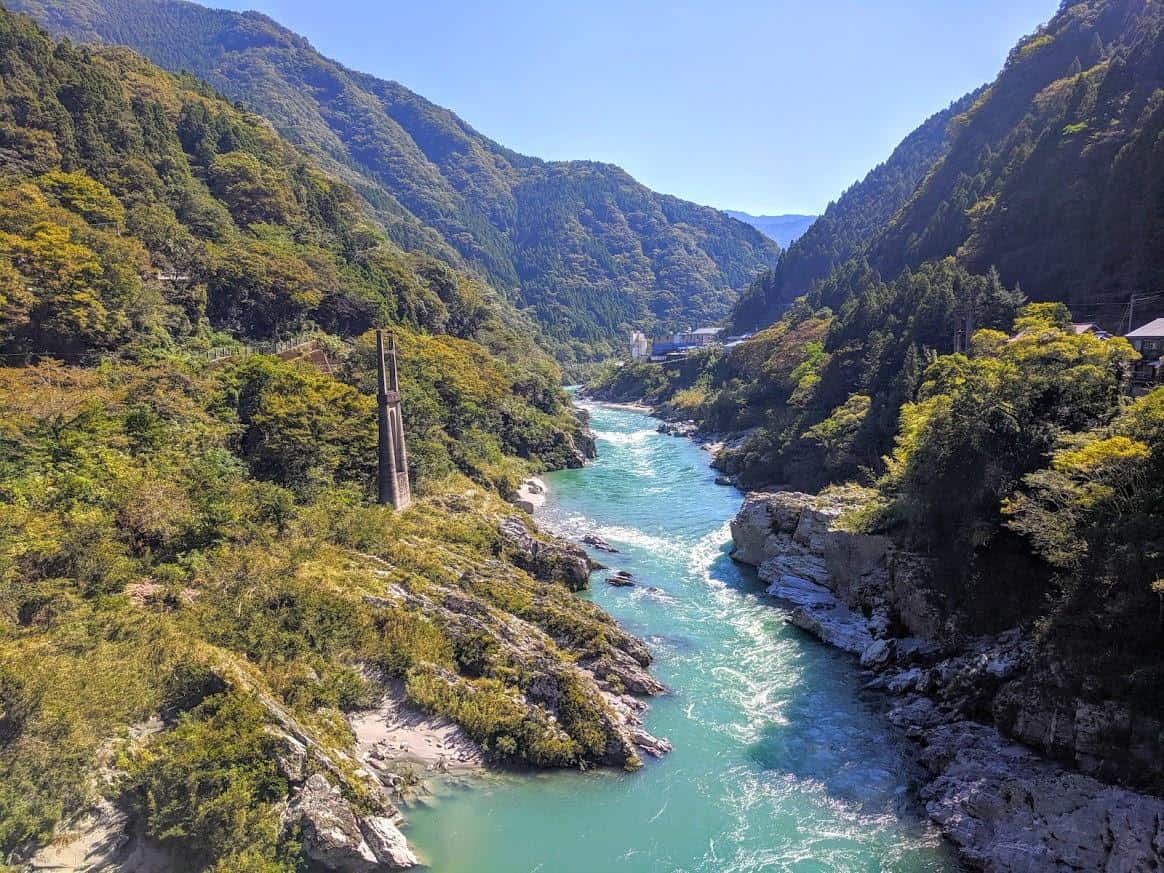
Oboke Gorge and the Yoshino River, Iya Valley
photography by: The Brownes
Vine bridges
There are a pair of vine bridges hanging side by side in Higashi Iya, known as the “couples bridges” or Oku Iya Ni-ju Kazurabashi. The “husband” bridge, Otto No Hashi, is 44m long while the “wife” bridge, Tsuma No Hashi, is 22m long. These are two of only 3 surviving monkey vine bridges left in Iya Valley and while they are harder to get to than the Iya Vine Bridge, they are far less touristy and worth the extra effort. It is believed that these bridges were first constructed around 800 years ago by the Heike clan fleeing into the mountains. Nowadays, the vines are completely replaced every 3 years for safety purposes. However, it is getting more difficult to maintain the bridges because the rate of growth of the vines can’t keep up with the number and size of the vines needed to replace the bridges.
Statue of the Peeing Boy
This statue is located at Nana Magari (Seven Curves). Local children would pee into the valley from this 200m sheer cliff to prove their courage. Not for the faint-hearted, this statue was erected as a deterrent against these young daredevils.
Iya Onsen
You can combine a visit to the Peeing Boy Statue with a visit to this traditional Japanese onsen. The open-air baths are accessed by a cable car from the hotel and you can easily relax for an hour here in the natural hot springs at the bottom of the valley.
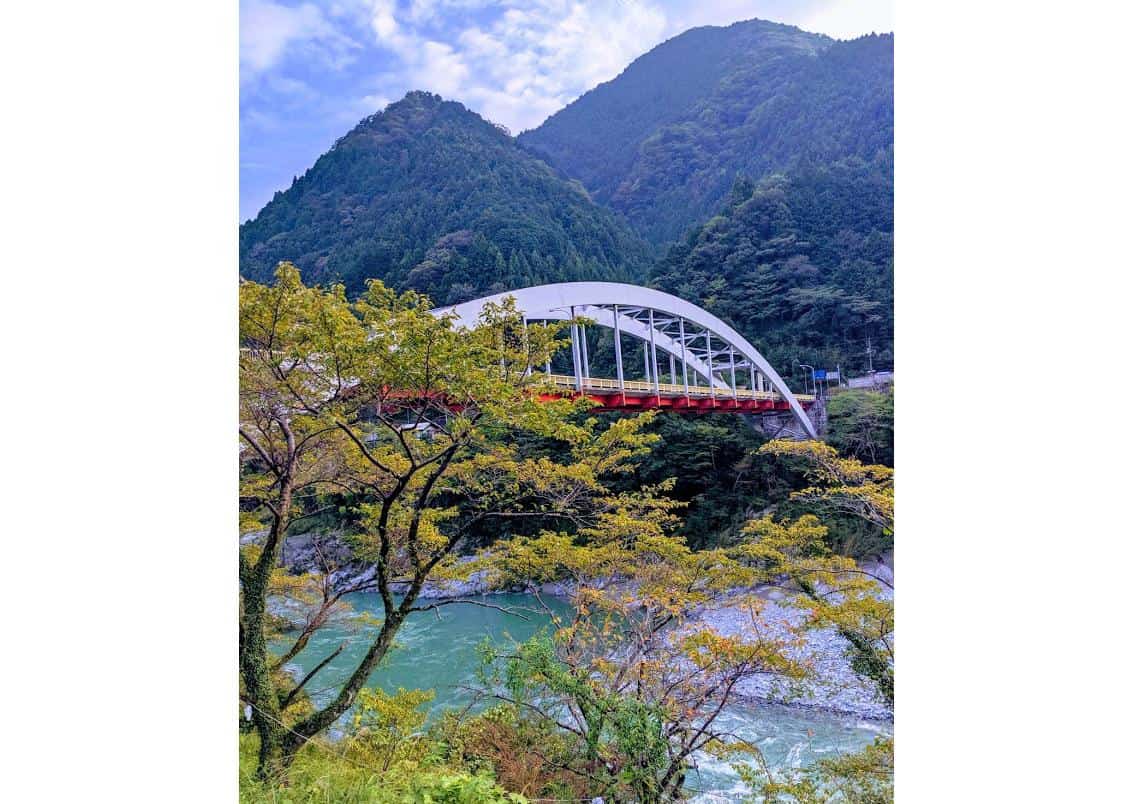
One of the many bridges spanning the gorge
photography by: The Brownes
From Tokyo, you can get to Iya Valley via 2 separate trains, all covered by the Japan Rail Pass. Because of the infrequency of the second train, this can take a while, as our total journey time (including waiting for trains) was over 7 hours.
Train 1: Shin-Okubo (Shinjuku, Tokyo) to Okayama: Shinkansen Hikari, 4 hours. If you don’t have the Japan Rail Pass, this will cost you 17,000 Yen. There is a faster train, Shinkansen Nozomi, which takes 3.5 hours but this is not available on the JRP.
Train 2: Okayama to Oboke: Dosan Line-Limited Express towards Kochi, 1 hr 40 minutes. 4,420 yen without JRP.
From Oboke, you can get a local bus (number 21 to Kubo) to Nagoro. These are very infrequent and there are only about 4 per day so you will have to plan ahead. The best way to get around Iya Valley is to have your own rental car but this was outside our backpacker budget so we relied on public transport and the kindness of strangers – a lovely Argentinian couple gave us a lift from Nagoro back to Oboke station when they spotted us walking along the road with no clue as to when the next bus might come along.

Some of the scarecrow residents of Nagoro Village
photography by: The Brownes
We are Sinéad and Adam, an Irish couple with an insatiable appetite for travel. After 6 months exploring South America in 2012, we subscribed to the corporate world for a few years to replenish our travel funds. In 2019, we packed our lives into backpacks once again, this time with no definitive end date and we have since travelled all around South East Asia and Turkey extensively, including an 8 month stay in the Philippines at the height of the COVID-19 pandemic. The travel horizon has changed a lot in the last year but we have a lot more of this wonderful world still to see so we are currently looking into how we can do that in the safest way possible. Life is for living and adventures await.
Instagram: @wherethefeckarewe

photography by: The Brownes